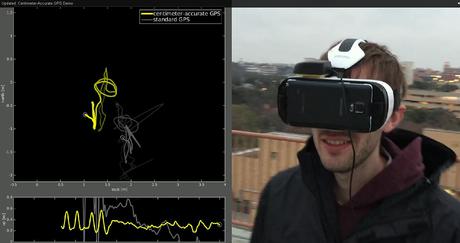Centimetre-accuracy GPS for mobile devices

A powerful and sensitive software-defined GPS receiver can extract centimetre accuracies from antennas found in mobile devices.
Researchers in the Cockrell School of Engineering at The University of Texas at Austin have developed a centimetre-accurate GPS-based positioning system that could revolutionise geolocation on virtual reality headsets, mobile phones and other technologies, making global positioning and orientation far more precise than is currently available on a mobile device.
The researchers’ new system could allow unmanned aerial vehicles to deliver packages to a specific spot on a consumer’s back patio, enable collision avoidance technologies on cars and allow virtual reality (VR) headsets to be used outdoors.
Coupled with a smartphone camera, the technology could be used to quickly build a globally referenced 3D map of one’s surroundings that would greatly expand the radius of a VR game. Currently, VR does not use GPS, which limits its use to indoors and usually a one-metre radius.
Lead researcher Todd Humphreys, assistant professor in the Department of Aerospace Engineering and Engineering Mechanics, and his team in the Radionavigation Lab have built a low-cost system that reduces location errors from the size of a large car to the size of a coin - a more than 100 times increase in accuracy.
Humphreys collaborated with Professor Robert W Heath from the Department of Electrical and Computer Engineering and graduate students on the new technology, which they describe in a recent issue of GPS World.
Centimetre-accurate positioning systems are already used in geology, surveying and mapping, but the survey-grade antennas these systems employ are too large and costly for use in mobile devices.
The breakthrough by Humphreys and his team is a powerful and sensitive software-defined GPS receiver that can extract centimetre accuracies from the inexpensive antennas found in mobile devices - such precise measurements were not previously possible.
The researchers anticipate that their software’s ability to leverage low-cost antennas will reduce the overall cost of centimetre accuracy, making it economically feasible for mobile devices.
Humphreys and his team have spent six years building a specialised receiver, called GRID, to extract so-called carrier phase measurements from low-cost antennas. GRID currently operates outside the phone, but it will eventually run on the phone’s internal processor.
To further develop this technology, Humphreys and his students recently co-founded a start-up, called Radiosense. The team is working with Samsung to develop a snap-on accessory that will tell smartphones, tablets and virtual reality headsets their precise position and orientation.
The researchers designed their system to deliver precise position and orientation information - how one’s head rotates or tilts - to less than one degree of measurement accuracy. This level of accuracy could enhance VR environments that are based on real-world settings, as well as improve other applications, including visualisation and 3D mapping.
Additionally, the researchers believe their technology could make a significant difference in people’s daily lives, including transportation, where centimetre-accurate GPS could lead to better vehicle-to-vehicle communication technology.
“If your car knows in real time the precise position and velocity of an approaching car that is blocked from view by other traffic, your car can plan ahead to avoid a collision,” Humphreys said.
Samsung provided funding to Humphreys’ Radionavigation Lab at UT Austin for the centimetre-accurate global positioning system research and plans to continue funding-related basic research.
Why traditional transformation approaches fail field workers
A critical misstep in traditional transformation strategies is failing to understand the...
RFUANZ report: setting the frequency for success in 2025
Last year brought a lot of internal change for RFUANZ, but the association has hit the ground...
ARCIA update: an extended event calendar for 2025
With the addition of Tasmanian events and a conference in Adelaide in September, 2025 will see...





